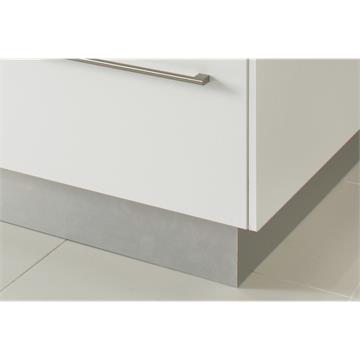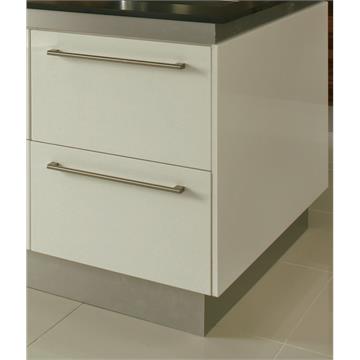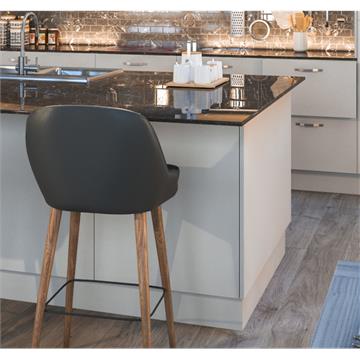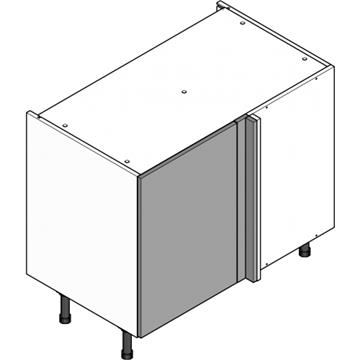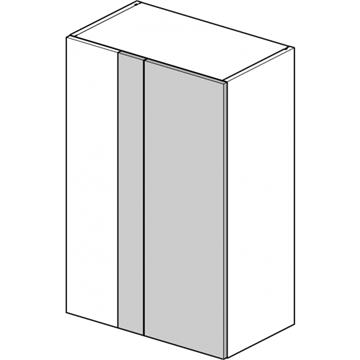
What are the Types of Kitchen Units?
There are a number of different types of kitchen units. We outline the various different ones that are available to you when buying your new kitchen.
Knowing which kitchen units are available, and how they are best used, is key to getting the most out of your kitchen, so it is worth sparing some time to learn the difference between the different types, and think how you can use them in your kitchen design.
Three Basic Types of Kitchen Units
There are three basic types of kitchen units available. These are base units, wall units and tall units. Base units sit on the floor, wall units fix to the wall, and tall units sit on the floor but are the full height of both the wall and base units. They usually align with the top of the wall units. Within each basic type of unit there are a number of difference sub-types of unit. We will work through these, one type at a time.
Hopefully once you've finished this help guide you will be able to decide which units, or combinations of units, work best in your new kitchen design. As always there is a balance between practicality and budget, so we will try and outline the pros and cons for all the units.
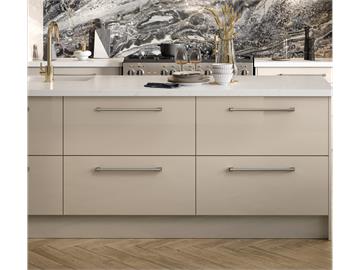
Base Units
Base units are the units that sit on the floor, normally on 150mm high legs. These units provide two functions. First of all they provide deep storage space, and secondly they provide a surface on top for you to place the worktop, sink, hob etc.
These units are normally 720mm high, sitting 870mm high off the floor including the legs (assuming the legs are set at 150mm high).
There are also variations of base units, for instance L-shaped corner units or corner blank units. These are available as either baseline or drawer line units (please see below for more details on these). L-shaped corner units have two doors. Blank corner units have one door. Half of the unit is hidden in the corner. These are often used with Le Mans style wireworks, that mean the entire unit is useable for space.
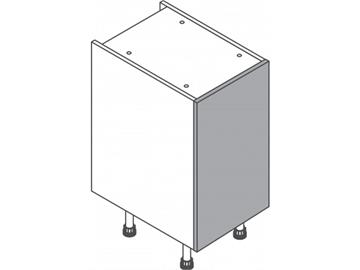
Baseline Units
Baseline unit are base units that have a door the full height of the units. These units come with one shelf as standard. They are the most common base unit, and are also the cheapest, as there are fewer components; one door for single units (150mm to 600mm wide), two for double units (above 600mm wide), no drawers, drawer fronts or other components.
The door are on these units is usually 715mm high, just slightly shorter than the unit itself, so allow for opening and closing the door without catching.
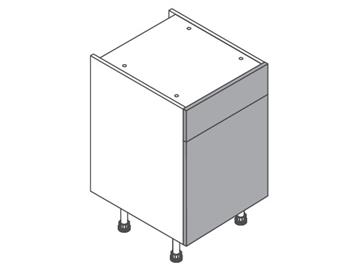
Drawer Line Units
Drawer line units are units that have a smaller door than the base line units, underneath a drawer. These used to be the standard units used, but have given way to baseline units more recently.
The overall unit height is once again 720mm high as standard. The drawer is 140mm high, usually considered to be a cutlery drawer. The door below is 570mm high as standard. Those two highs, along with some gaps to avoid catching, make up the 720mm height of the unit.
As this has at least one door and drawer, and a drawer box (the internal components of the drawer) they are more expensive to buy than baseline units, but do offer additional storage in terms of drawers space.
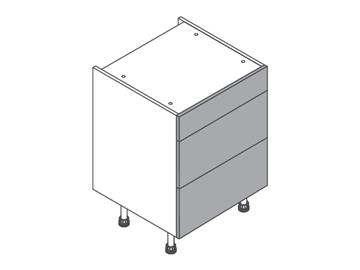
Drawer Units
These units are also 720mm high base units. This time instead of either one door or a drawer and door, the unit comprises of a number of drawers with no cupboard space, only drawer space.
There are a number of different combination of drawer units available, from traditional four or five drawer that are the same size, to either two or three drawers. With the two or three drawer combination two of the drawers are normally pan drawers. There are two depth of pan drawers. The main feature to pan drawers are the additional height compared to a cutlery drawer, offering very useful for storage.
Due to there being extra components in these units, they are the most expensive base units, but they are by far the most useful, so we would recommend using as many as your budget can afford.
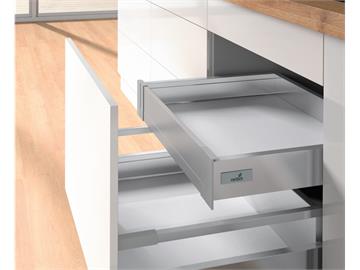
Internal Drawer Units
These are relatively new units on the market. They offer a fantastic hybrid solution to base units. Offering the clean lines of a baseline unit with the practicality of a drawer unit.
There are various configurations available, but typically involve two setups. Either opening a door to reveal multiple internal drawers. These drawers are set back slightly, and the door requires 165 degree hinges rather than the usual 110 degree hinges. This gives greater clearance so the internal drawers don't catch on the inside of the door.
The alternative configuration is where the door is fixed to the bottom drawers. The drawer/door opens on the drawer rails, rather than hinges. Once again there are normally additional internal drawers within the unit.
There has been a massive increase of people using this type of unit in their kitchen design in recent years. They offer a similar style to the full larder units, but don't take up as much space, so are a good alternative when space is at a premium.

Wall Units
As the name suggests, these units are the ones that hang on the wall. There are a number of different wall units available.
Wall units are often available in three different heights. Small, typically 570mm high, medium (or standard) 720mm high, and tall wall units at 900mm high. Small 570mm wall units have almost disappeared now, having largely been replaced by medium units.
In addition to these sizes there are also a number of other types of wall units available. These include glazed units, corner units and top boxes. Shelving instead of wall units can also be used, although after a short fad in the late 2010s, these have now largely fallen out of favour. This is due to the additional cleaning demands from having items out on the side permanently, as dirt, dust and grime builds up quicker here than in closed units.
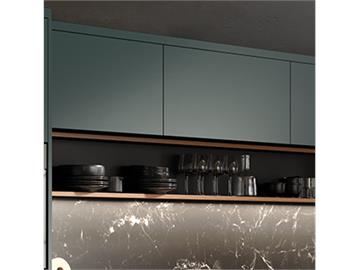
Other Wall Units
As well as the three standard wall units there are a number of other units to consider.
Top Box Wall Units
These are half the size of a standard 720mm high wall unit. They can be to run along the top of something, such as an American fridge freezer. They can also be doubled up to offer a different type of wall units, with the doors opening on top (although they can also have the doors opening to the left/right too). These top boxes can also be used as open units, as in the picture, to store things without a door.
Glazed Wall Units
Glazed wall units are similar to normal units, but have some or all of the door replaced with glazing. Sometimes the glazing can be the majority of the door, but you can also get portal style glazed doors, or letterbox glazing, like in the image at the top of the page.
Corner Wall Units
As the name suggests, these are the units used in the corner of the wall run. They can be diagonal units or corner wall units with a blank, although the diagonal units have largely fallen out of favour with kitchen designers now.
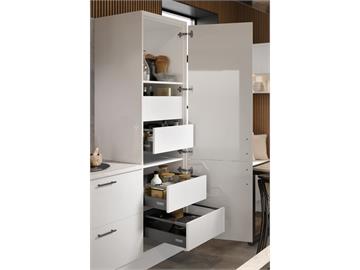
Tall Units
Tall units are full height units. They stand on the floor on legs. The term tall unit normally covers a two types of units; larder units and appliance housing. These are very popular for those who have large kitchen with plenty of space and light as they offer lots of practical space.
Larder Units
Larder units are the modern equivalent to the traditional larder in older kitchens. They are often plain units with two doors. The doors normally match the run of base units, plus a top door, so a 720mm bottom door with a 1245mm top door for standard larder units, and an additional 175mm top blanking plate for tall larder units. This mean they look aesthetically correct when they are placed next to standard base units, as the line of the bottom door matched the rest of the run of cabinets.
Within the cabinets, there is usually a combination of shelves, in standard units, and drawers and shelves in hybrid larder units with internal drawers. As always with kitchens, the more drawers the better, but it is obviously subject to budget, as drawers cost more than just a shelf within a unit.
Appliance Housing
Appliance housing is for integrated appliances, such as integrated fridges and freezers, and also for ovens. Once again they offer a great practical space for you to use, subject to space and budget. There are many different combinations of cabinets available. We would suggest checking out our 'Kitchen Door Combinations' guide for more details.

